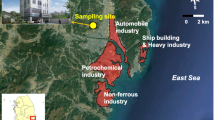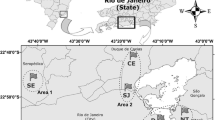Abstract
Polycyclic aromatic hydrocarbons (PAHs) are considered to be atmospheric pollutants and well-known human carcinogens. This study analyzes the pollution scenarios of PAHs in the aerosol of Higashi Hiroshima, Japan. We examined the characteristics, the influences of meteorological conditions, the distribution and seasonal variation of PAHs in aerosol samples collected from June 2000 to May 2001. The concentration of PAHs in the aerosol of Higashi Hiroshima was ranging from 11.8 to 157.5 μg/g with a mean concentration of 63.4 μg/g. Results showed that there is positive correlation between aerosol PAH concentrations and ambient temperature but a relatively little correlation with solar radiation. Seasonal variation was observed with a higher concentration during winter and lower concentration during summer. Apart from that, principal component analysis and molecular diagnostic ratios were also used to characterize and identify possible PAHs emission sources. Results obtained strongly suggested that vehicular emissions appeared to be the major source of aerosol PAHs in this study although other sources do have some degree of influence.




Similar content being viewed by others
References
Air quality guidelines for Europe (2000). Second edition, WHO regional publication, Europeans series, 91.
Bostrom, C. E., Grede P., Hamberg A., Jenstrom B., Johansson C., & Kyrklund T. (2002). Cancer risk assessment, indicators, and guilenes for polycyclic aromatic hydrocarbons in the ambient air. Environmental Health Perspectives, 110(3), 451–488.
Bourotte, C., Forti, M. C., Taniguchi, S., Bicego, M. C., & Lotufo, P. A. (2005). A wintertime study of PAHs in fine and coarse aerosols in Sao Paulo city, Brazil. Atmospheric Environment, 39, 3799–3811.
Chang, K. F., Fang, G. C., Chen, J. C., & Wu, Y. S. (2006). Atmospheric polycyclic hydrocarbons (PAHs) in Asia: A review from 1999 to 2004. Environmental Pollution, 142, 388–396.
Chetwittayachan, T., Shimazaki, D., & Yamamoto, K. (2002). A comparison of temporal variation of particle-bound polycyclic aromatic hydrocarbons (pPAHs) concentration in different urban environments: Tokyo, Japan, and Bangkok, Thailand. Atmospheric Environment, 36, 2027–2037.
Dallarosa, J. B., Monega, J. G., Teixeira, E. C., Stefens, J. L., & Wiegand, F. (2005). Polycyclic Aromatic Hydrocarbons in atmospheric particles in the metropolitan area of Porto Alegre, Brazil. Atmospheric Environment, 39, 1609–1625.
Fan, Z., Chen, D., Birla, P., & Kamens, R. M. (1995). Modeling of nitro-polycyclic aromatic hydrocarbon formation and decay in the atmosphere. Atmospheric Environment, 29, 1171–1181.
Fang, G. C., Chang, C. N., Wu, Y. S., Fu, P. C., Yang, I. L., & Chen, M. H. (2004). Characterization, identification of ambient air and road dust polycyclic aromatic hydrocarbons in central Taiwan, Taichung. Science of the Total Environment, 327, 135–146.
Hayakawa, K., Tang, N., Akutsu, K., Murahashi, T., Kakimoto, H., Kizu, R., et al. (2002). Comparison of polycyclic aromatic hydrocarbons and nitropolycyclic aromatic hydrocarbon in airborne particulates collected in downtown and suburban Kanazawa, Japan. Atmospheric Environment, 36, 5535–5541.
Hiroshima University Meteorological Monitoring data (n.d.) Retrieved September 8, 2006, from http://home.hiroshima-u.ac.jp/hirodas/.
Izumikawa, S., Ise, H., Kan, K., Fukuoka, S., Funeshima, M., Yokota, H, et al. (1989). The variation of polycyclic aromatic hydrocarbons in the exhaust gas of gasoline vehicle. Annual report (year 1989) of East Kyoto Environmental Science Research Centre., (in Japanese) 24–35.
Jenkins, B. M., Jones, A. D., Turn, S. Q., & Williams, R. B. (1996). Emissions factor for polycyclic aromatic hydrocarbon from biomass burning. Environmental Science and Technology, 30, 2462–2469.
Kakimoto, H., Matsumoto, Y., Sakai, S., Kanoh, F., Aras, K., Tang, N., et al. (2002). Comparisons of atmospheric polycyclic hydrocarbons and nitropolycyclic aromatic hydrocarbons in an industrialized city (Kitakyushu) and two commercial cities (Sapporo and Tokyo). Journal of Health Science, 48, 370–375.
Kakimoto, H., Yokoe, H., Matsumoto, Y., Toriba, A., Kizu, R., & Hayakawa, K. (2001). Considerations of atmospheric behaviors of polycyclic aromatic hydrocarbons, nitropolycyclic aromatic hydrocarbons and inorganic pollutants based on their correlationships. Journal of Health Science, 47, 385–393.
Kameda, Y., Shirai, J., Komai, T., Nakanishi, J., & Masunaga, S. (2005). Atmospheric polycyclic aromatic hydrocarbons: Size distribution, estimation of their risk and their depositions to human respiratory tract. Science of the Total Environment, 340, 71–80.
Kamens, R. M., Guo, Z., Fulcher, J. N., & Bell, D. A. (1988). Influence of humidity, sunlight, temperature on the daytime decay of polycyclic hydrocarbons on atmospheric soot particles. Environmental Science and Technology, 22, 103–108.
Khalli, N. R., Scheff, P. A., & Holsen, T. M. (1995). PAHs source fingerprints for coke ovens, diesel and gasoline engines, highway tunnels, and wood combustion emissions. Atmospheric Environment, 29, 533–542.
Lee, J. Y., Kim, Y. P., Kang, C. H., & Ghim, Y. S., (2006). Seasonal trend of particulate PAHs at Gosan, a background site in Korea between 2001 and 2002 and major factors affecting their levels. Atmospheric Research, 82, 680–687.
Li, C. K., & Kamens, R. M. (1993). The use of polycyclic aromatic hydrocarbons as sources signatures in receptor modeling. Atmospheric Environment, 159, 185–200.
Ohura, T., Amagai, T., Fusaya, M., & Matsushita, H. (2004). Spatial distributions and profiles of atmospheric polycyclic aromatic hydrocarbons in two industrial cities in Japan. Environmental Science and Technology, 38, 49–55.
Omar, N. Y. M. J., Abas, M. R., Ketuly, K. A., & Tahir, N. M. (2002). Concentration of PAHs in atmospheric (PM-10) and roadside soil particles collected in Kuala Lumpur, Malaysia. Atmospheric Environment, 36, 247–254.
Ozaki, N., Takeuchi, S., Fukushima, T., & Komatsu, T. (2005). Decrease of polycyclic aromatic hydrocarbons (PAHs) associated with atmospheric aerosols and deposited particulate matter in atmospheric environment. Atmospheric Environment, 40, 238–249, (in Japanese).
Panther, B. C., Hooper, M. A., & Tapper, N. J. (1999). A comparison of air particulate matter and associated polycyclic aromatic hydrocarbons in some tropical and temperate urban environments. Atmospheric Environment, 33, 4087–4099.
Park, S. S., Kim, Y. J., & Kang, C. H. (2002). Atmospheric Polycyclic Aromatic Hydrocarbon in Seoul, Korea. Atmospheric Environment, 36, 2917–2924.
Simcik, M. F., Eisenreich, S. J., & Lioy, P. J. (1999). Source apportionment and source/sink relationship of PAHs in the coastal atmosphere of Chicago and Lake Michigan. Atmospheric Environment, 33, 5071–5079.
Tan, J. H., Bi, X. H., Duan, J. C., Rahn, K. A., Sheng., G. Y., & Fu, J. M. (2006). Seasonal variation of particulate polycyclic aromatic hydrocarbons associated with PM10 in Guangzhou, China. Atmospheric Research, 80, 250–262.
Tang, N., Hattori, T., Taga, R., Igarashi, K., Yang, X., Tamura, K., et al. (2005). Polycyclic aromatic hydrocarbons and nitropolycyclic aromatic hydrocarbons in urban air particulates and their relationship to emission sources in the Pan-Japan Sea countries. Atmospheric Environment, 39, 5817–5826.
Venkataraman, C., Negi, G., Sarder, S. B., & Rastogi, R. (2002). Size distribution of polycyclic aromatic hydrocarbons from biofuel combustion. Journal of Aerosol Science, 33, 503–518.
Yang, H. H., Lee, W. J., Chen, S. J., & Lai S. O. (1998). PAHs emission from various industrial tracks. Journal of Hazardous Materials, 60, 159–174.
Author information
Authors and Affiliations
Corresponding author
Rights and permissions
About this article
Cite this article
Fon, T.Y.W., Noriatsu, O. & Hiroshi, S. Polycyclic Aromatic Hydrocarbons (PAHs) in the Aerosol of Higashi Hiroshima, Japan: Pollution Scenario and Source Identification. Water Air Soil Pollut 182, 235–243 (2007). https://doi.org/10.1007/s11270-007-9335-y
Received:
Accepted:
Published:
Issue Date:
DOI: https://doi.org/10.1007/s11270-007-9335-y




